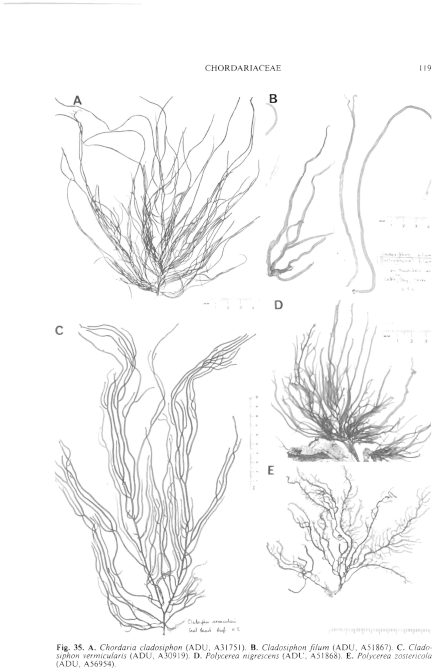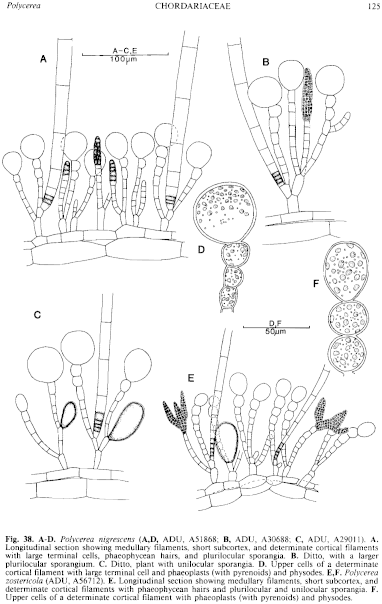|
|
|
|
|
|||||||||||
|
Electronic Flora of South Australia Species Fact Sheet
Phylum Phaeophyta – Order Chordariales – Family Chordariaceae
Selected citations: Bailey & Womersley in Womersley 1967: 234.
Synonym
Cladosiphon zostericola Harvey ex Kützing 1859: 1, pl. 1 fig. I. Kuckuck 1929: 58, fig. 75.
Thallus (Fig. 35E) medium brown, mucoid, relatively soft, much branched with frequent short laterals, cylindrical, 2–20 cm long and 1–2 mm in diameter, epiphytic on Posidonia australis, P. sinuosa and Amphibolis antarctica. Medulla multiaxial, becoming hollow, of parallel, cylindrical, longitudinal filaments 20–40 µm in diameter with cells L/B 3–8, slenderer at the periphery, with only slight development of hyphae. Subcortex slight, usually of 1 (–2) cells each 10–16 µm in diameter and L/B (1–) 1.5–3. Cortical filaments (Fig. 38E) arising in small groups from subcortical cells, forming a moderately dense layer with slightly curved filaments 100–160 µm and 8–13 cells long, lower cells 6–10 µm in diameter and L/B 1.5–3, with the upper 3–4 cells larger, subspherical, increasing in diameter upwards, with subterminal cells 12–20 µm in diameter and the terminal cell subglobose to slightly ovoid, 22–32 µm in diameter, and 1.5–2 times the diameter of the subterminal cell. Phaeoplasts (Fig. 38F) several per cell, discoid, probably each with a pyrenoid; physodes sparse. Phaeophycean hairs (Fig. 38E) frequent, arising from outer subcortical cells, 8–16(48) µm in diameter.
Reproduction: Plurilocular sporangia (Fig. 38E) borne on pedicels of 4–6 cells from the subcortical cells, usually once or twice furcate or branched, with the arms tapering or lanceolate, multiseriate, 30–60 m long and 12–16 µm in diameter. Unilocular sporangia (Fig. 38E) borne on basal cells of cortical filaments or on upper subcortical cells, sessile, ovoid, 35–60 µm long and 25–40 µm in diameter.
Type from King George Sound, W. Aust. (Harvey, Alg. Aust. Exsicc. 98B); in Herb. Sonder, MEL, 8618.
Distribution: From Rottnest I., Point Peron and King George Sound, W. Aust., as a summer annual.
Taxonomic notes: As well as the type, known from Fish Hook Bay, Rottnest I., W. Aust., upper sublittoral on Posidonia australis (Gordon-Mills, 6.xii.1984; ADU, A56712). Nancy Cove, Rottnest I., W. Aust., 3–4 m deep on Amphibolis antarctica, Posidonia sinuosa and P. australis (Walker, 26.xi.1985; ADU, A56954-"Marine Algae of southern Australia" No. 258). Point Peron, W. Aust., drift and upper sublittoral on P. australis (Woelkerling, 15.xi.1968; ADU, A34265 and Womersley 29.ix.1979; ADU, A51030).
P. zostericola (Harvey generally referred to Posidonia as Zostera) is not well known, but typical specimens are distinct from P. nigrescens in their cortical filaments, hairs, in the form of the plurilocular sporangia, and also in habit, with P. zostericola having more frequent, short, lateral branches than does P. nigrescens. However, a few collections of possible inter-grades [e.g. near Army Jetty, Thomson Bay, Rottnest I., W. Aust., 2–3 m deep on P. australis (Engler, 7.ix.1979; ADU, A51128)] have been seen and further studies are needed on their relationships and seasonal and ecological variation.
References:
KÜTZING, F.T. (1859). Tabulae Phycologicae. Vol. 9. (Nordhausen.)
KUCKUCK, P. (1929). Fragmente einer Monographie des Pheosporeen. Biol. Anst. Helgol. 17, 1–93.
KYLIN, H. (1940). Die Phaeophyceenordnung Chordariales. Acta Univ. lund. N.F. Avd. 2, 36(9), 1–67, Plates 1–8.
WOMERSLEY, H.B.S. (1967). A critical survey of the marine algae of southern Australia. II. Phaeophyta. Aust. J. Bot. 15, 189–270.
The Marine Benthic Flora of Southern Australia Part II complete list of references.
Publication:
Womersley, H.B.S. (14 December, 1987)
The Marine Benthic Flora of Southern Australia
Part II
©Board of the Botanic Gardens and State Herbarium, Government of South Australia
Illustrations in Womersley Part II, 1997: FIGS 35E, 38E,F.

Figure 35 enlarge
Fig. 35. A. Chordaria cladosiphon (ADU, A31751). B. Cladosiphon filum (ADU, A51867). C. Cladosiphon vermicularis (ADU, A30919). D. Polycerea nigrescens (ADU, A51868). E. Polycerea zostericola (ADU, A56954).

Figure 38 enlarge
Fig. 38. A–D. Polycerea nigrescens (A,D, ADU, A51868; B, ADU, A30688; C, ADU, A29011). A. Longitudinal section showing medullary filaments, short subcortex, and determinate cortical filaments with large terminal cells, phaeophycean hairs, and plurilocular sporangia. B. Ditto, with a larger plurilocular sporangium. C. Ditto, plant with unilocular sporangia. D. Upper cells of a determinate cortical filament with large terminal cell and phaeoplasts (with pyrenoids) and physodes. E,F. Polycerea zostericola (ADU, A56712). E. Longitudinal section showing medullary filaments, short subcortex, and determinate cortical filaments with phaeophycean hairs and plurilocular and unilocular sporangia. F. Upper cells of a determinate cortical filament with phaeoplasts (with pyrenoids) and physodes.

|
Email Contact: State Herbarium of South Australia |

|